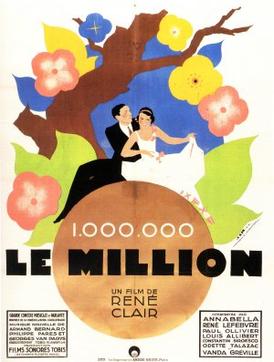The opening sequence of the 1931 French film, Le Million, by Rene Clair, is great. A medium-long shot of a man and a woman saying goodnight at the window of each person’s flat is followed by stylized footage of Paris rooftops and then a scurrying of two figures to the skylight of one of these roofs. It’s an enchanting sequence, but then Le Million is an enchanting musical comedy, a brave if idiosyncratic adaptation of a play.
Michel (Rene Lefevre) is not a very lovely hero, really, but he is entitled to the million florins that a Dutch lottery ticket ensures for him. He just has to retrieve the jacket in whose pocket the ticket can be found. It’s missing. . . The film’s humor is droll, though there’s no wit: The dialogue, you see, is improvised. The music, some of it operatic, is often pleasant, curiously featured as though it were beside the point. The cast is generally fun, the leading lady (Annabella—one name only) inarguably, unglamorously pretty.
It’s Clair all the way.
(In French with English subtitles)



